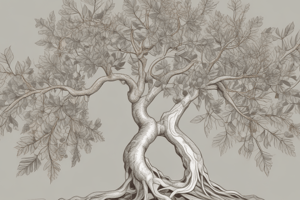Podcast
Questions and Answers
What are the main functions of roots and stems in plants?
What are the main functions of roots and stems in plants?
Roots and stems are responsible for supporting the plant structurally and transporting nutrients to the rest of the plant.
What are the two main categories of flowering plants?
What are the two main categories of flowering plants?
The two main categories of flowering plants are monocots and dicots.
Name two examples of gymnosperms.
Name two examples of gymnosperms.
Two examples of gymnosperms are pine and cedar trees.
What are the main functions of a plant stem?
What are the main functions of a plant stem?
How do the vascular bundles of a monocot stem differ from those of a dicot stem?
How do the vascular bundles of a monocot stem differ from those of a dicot stem?
What are some examples of plant structures that are technically stems but look more like roots?
What are some examples of plant structures that are technically stems but look more like roots?
How are roots and stems alike?
How are roots and stems alike?
Describe the structure of a root and its main functions in a plant.
Describe the structure of a root and its main functions in a plant.
Explain the difference between taproot and fibrous root systems.
Explain the difference between taproot and fibrous root systems.
What is the function of a stem in a plant?
What is the function of a stem in a plant?
Flashcards
Roots and Stems
Roots and Stems
Provide structural support and transport nutrients throughout the plant.
Angiosperms
Angiosperms
Flowering plants divided into monocots (grasses, onions, lilies) and dicots (deciduous trees, carrots, beets).
Primary Roots
Primary Roots
Grow downwards, protected by a root cap, and use root hairs to acquire water.
Xylem
Xylem
Signup and view all the flashcards
Nodes
Nodes
Signup and view all the flashcards
Root Functions
Root Functions
Signup and view all the flashcards
Taproot System
Taproot System
Signup and view all the flashcards
Stem Functions
Stem Functions
Signup and view all the flashcards
Dicots Stems
Dicots Stems
Signup and view all the flashcards
Rhizomes
Rhizomes
Signup and view all the flashcards
Study Notes
Roots and Stems Similarities
- Almost every plant has roots and stems, responsible for supporting the plant structurally and transporting nutrients to the rest of the plant.
- Both roots and stems have similar functions, such as uptake of water and nutrients from the soil, and act as pathways for food to be transported from the leaves to other parts of the plant.
Stem and Root Structure
- Most plants have a basic organization of parts, including roots, stems, and leaves.
- Angiosperms (flowering plants) are divided into two groups: monocots (grasses, onions, lilies) and dicots (deciduous trees, carrots, beets).
- Gymnosperms (conifers, ginkgo trees) and ferns represent other categories of vascular plants.
- Roots and stems of each group have important structural differences.
Root Structure
- Primary roots grow downwards, while secondary roots grow outward.
- The root tip has a root cap that protects the root as it grows, and root hairs aid in acquiring water.
- Within the root, two main types of vascular tissue are found: phloem (plant food transportation) and xylem (water and nutrient transportation).
- Surrounding the phloem and xylem is the ground tissue, which may store extra starch.
Stem Structure
- The stem is part of the plant's shoot system, composed of several parts.
- Nodes grow at specific segments of the stem, and different structures grow from nodes, such as leaves, secondary stems, flowers, and cones.
- The interior structure of stems is similar to that of roots, with epidermis, vascular bundles, and cortex surrounding the vascular bundles.
Functions of Roots in Plants
- Roots absorb water and nutrients from the soil.
- Roots transport water and nutrients to other parts of the plant.
- Roots anchor the plant to the ground, providing stability and support.
- Roots search for water and nutrients in the soil.
- Roots can store extra food in the form of starch.
Types of Roots
- Taproot systems (dicots, conifers) have a single root that extends downward and grows secondary roots.
- Fibrous root systems (monocots, ferns) have a series of roots that grow from the stem base.
Functions of a Stem in a Plant
- Stems provide structure and support to above-ground parts of the plant.
- Stems transport nutrients and water up from the roots to the leaves and other parts.
- Stems transport food from the leaves down to other parts of the plant.
- Stems play a role in photosynthesis, with photosynthetic material within the epidermis layer.
Types of Stems
- Dicots have vascular bundles arranged in a ring around the middle of the stem.
- Monocots have vascular bundles scattered throughout the stem, more around the extremity than in the center.
- Gymnosperms have a more primitive type of xylem tissue known as tracheids.
Adaptations of Stems
- Rhizomes are horizontally growing stems that travel along the ground and send out roots and shoots.
- Tubers are starch-filled underground stems used for extra energy storage.
- Corms are similar to tubers but grow at the base of stems and are used for extra food storage.
Studying That Suits You
Use AI to generate personalized quizzes and flashcards to suit your learning preferences.




